Patrice Sarath's Blog, page 13
July 30, 2017
ArmadilloCon 39 — August 4-6
ArmadilloCon is almost here! I can’t believe it — it’s come up fast. First and most important, You ask: “Patrice! When are you doing your reading?!”
Why, that will be at 9 pm on Saturday night. So come to the reading for some pre-party floor fun and we’ll kick off the Saturday night revelry in style. I’ll have snacks and beverages and a selection from the super-secret new project.
The next thing you ask: “Patrice, what are you second-most excited about?”
Why, that will be the interview with Tamora Pierce, special guest. Bring your tattered copies from the Scholastic book fairs that you bought with your babysitting money, clutched to your chest, and let’s all fangirl for a while. It’s good for the soul.
Sa1100 Short Fiction, Magazines vs. Online
Sat 11:00 AM-Noon Ballroom D
D. Afsharirad, D. Cherry, G. Faust, Ma. Finn*, T. Quachri, P. Sarath
Gardner Dozois has been warning of the extinction of SF magazines for decades. Are online venues the nail in the coffin, or a possible chance for regeneration?
Sa1600 Special Guest Interview
Sat 4:00 PM-5:00 PM Ballroom D
T. Pierce, P. Sarath*
Sa1900 Short story vs novel
Sat 7:00 PM-8:00 PM Ballroom D
T.E. Bakutis, U. Fung, M. Muenzler, L. Marley*, P. Sarath, W. Spencer,
What makes the short story so different from the novel? Panelists discuss the characteristics of each genre, including pacing, plotting, character development, Big Idea, and other aspects, and how they differ in each format.
Sa2100 Reading
Sat 9:00 PM-9:30 PM Southpark A
Patrice Sarath
July 4, 2017
The Big Shuffle: July 4 Ruminations
“Travel is fatal to prejudice, bigotry, and narrow-mindedness, and many of our people need it sorely on these accounts. Broad, wholesome, charitable views of men and things cannot be acquired by vegetating in one little corner of the earth all one’s lifetime.” — Mark Twain
So I’ve been mulling a fix for our political situation. So what I propose is this: We’ll call it The Big Shuffle*. Every five years, people will be reassigned new places to live, so that at any given time, 10 percent of the population has been shifted somewhere new. Kids have to start new schools, city folk have to move to a rural town and vice versa.
You’d have new people moving in all the time, and you’d have new ideas, new cuisine, new friends and enemies. You’d have to make people welcome and help them find their footing, and in turn, when you moved, you’d get the same welcome. And most importantly, you’d have to learn to think the best of everyone, because you’d find yourself in the same situation eventually.
People would have to learn to say Coke instead of pop, hoagies instead of heroes. They’d learn new favorite pizzas. NASCAR fans would become IndyCar fans. I know, right?!
It would take such courage, to both arrive in town and to meet the new arrivals. On Shuffle Day, everyone would come out to Main Street or Market Street or Fifth Avenue, and applaud the moving vans coming to town. When your new neighbors settled in, you’d bring over casseroles and tell them about their predecessors, and ask where they’re from and say, “I was there in 2017! That was the first year of The Big Shuffle! Do you know–”
And they would know! And you’d talk about these folks who were friends and neighbors and how you still keep in touch.
And you’d teach them where the best coffee is and the best diner and the best date night restaurant (all of which change, because of course business owners would shuffle too.) And your kids and their kids would become friends, and if you didn’t have kids, your dogs and their dogs would become friends.
And you’d have to learn to live light, right? So maybe all the things tying us down, both physical and metaphysical, will have to be released, allowing us to move about with freedom and lightness. We could become a nomadic culture, and instead of viewing strangers with suspicion, since we will all be strangers at some time, we would view them with recognition and welcome.
Oh, it would take such courage, but can you imagine what we’d get in return? No longer would we exist at the mercy of those who want to build walls (yes, I’m going there) between us, as if these walls had any value other than to keep us frightened of our own humanity and unable to recognize humanity in others.
It’s a crazy idea. To leave behind everything I’ve worked for, you cry. This house, this home, this yard, my roots. But that’s just it — nomads bring their roots with them. And you won’t leave behind who you are. Just stuff that you have.
So what do you think? Who is ready to make the first move? Can you imagine, moving in next to someone you’ve never met before, and they offer you a casserole and hold out their hand in welcome? “Hello, ” they will say. “Where are you from? Oh, my sister lived there five years ago. Did you know–”
And you will know.
*A spin on The Big Sort, which is how Americans have settled into these tribal districts and we don’t talk to anyone outside of our own echo chamber anymore.
May 18, 2017
On “Anne with an E”
 My copy of Anne of Green Gables. Ancient and well-loved.
My copy of Anne of Green Gables. Ancient and well-loved.There’s no equivalent to Anne Shirley in literature for boys. Harry Potter has not yet stood the test of time, and anyway, there are as many girls as boys who love Harry. Maybe Call of the Wild? Treasure Island? Kim? But do boys even read those books anymore? And do men remember the legendary characters of their childhood with the same ferocity and protection that women remember Anne?
Anne Shirley is a force unto herself, a literary heroine who is an icon of children’s literature. She is the ur-orphan, the red-headed parentless child who redeems her adoptive parents, as orphans in literature have done since — well, Moses? Anyway, Anne is beloved not only in Western literature but all over the world. Japanese fans make pilgrimages to Green Gables on Prince Edward Island. Her sunny personality and gentle adventures have charmed for generations.
But there has always been a darker side to Anne. It’s there in her sad backstory — orphaned as an infant, farmed out as an indentured servant at a very young age. Anne in real life would have died young, or grown up hardened, bitter, un-lettered, and certainly broken. It’s that backstory that Moira Walley-Beckett mines for her new retelling of Anne of Green Gables, “Anne with an E.” This is not your mother’s Anne, or your daughter’s. It’s certainly not the well-loved 1985 miniseries starring Megan Follows, a series with a fanbase so deeply invested in the show that it may even have toppled the book as the “true” version of L.M. Montgomery’s classic.
In a way, Walley-Beckett’s retelling is a homage to the original story, by taking the backstory and bringing it to the forefront. It is as if she is saying, “here is what made your jolly heroine what she has become. This is the fire in which the sword was forged.” I admire her purpose, even as I was disappointed in her execution.
For example, here are, from memory, the many adventures of Anne Shirley in Anne of Green Gables:
She insults Mrs. Rachel Linde after that lady tweaks her about her looks, then makes the best apology she can think of, and wins Rachel over to her side
She doesn’t lose Marilla’s amethyst brooch, but says she does anyway (it’s a long story), and then the brooch is found, and Anne gets to go to the church picnic and eat ice cream.
She gets Diana drunk on currant wine
She makes an inedible cake for Mrs. Stacy, the reverend’s wife
She is teased by Gilbert Blythe, cracks a slate across his head, which scandalizes the schoolroom, and never speaks to him again until they are teenagers.
She dyes her hair green. (Oh, Anne)
She walks a ridgepole, falls and breaks her ankle, and faints, which achieves another one of her life goals (fainting is romantic)
She saves Minnie May’s life because she knows what to do for croup
She jumps on Aunt Barry’s bed and Aunt Barry is in it
She gets a dress with puffed sleeves
Here are some of the mishaps in “Anne with an E:”
Marilla accuses Anne of stealing the brooch and losing it, and then SENDS HER BACK TO THE ORPHANAGE
Anne, while alone at the train station, is almost abducted by a pedophile
Matthew gallops off to get her back after the brooch is found, and hits his head and finally takes her home — in time for the picnic, which we don’t even get to see.
Anne saves the day when Ruby Gillis’s house almost burns down
Anne is mercilessly teased by the children at school; Moody Spurgeon or somebody keeps calling her a dog
Anne gets her period (this a brilliant scene, and kudos to Walley-Beckett for that one)
Matthew doesn’t lose all the money when the bank fails but instead when a ferry sinks with their crops and there is no insurance (That, by the way, is the plot of Reversal of Fortune)
Matthew Cuthbert ATTEMPS SUICIDE
Anne and Jerry go to pawn all of their belongings in Carmody, Jerry gets mugged by two drifters, the drifters decide their next move is to go to Green Gables, which Marilla has advertised to take in boarders, and we are left at the end of the season on a cliff-hanger, in which one can only guess the two drifters go full-on In Cold Blood on the family. There will probably be an attempted rape.
To create her new series, Walley-Beckett not only plunged into Anne’s backstory, she created a new character, and new secondary characters, with the same names as the originals but completely different. And she had to layer modern-day ills on top of the culture and mores of 100 years previous, and in so doing, she created a shoddy mechanism of a plot, so baldly laid out in dialog and action that one could almost see the story notes on the page. She misrepresented Anne, Avonlea, Green Gables, all of the denizens of the story, in order to do — what? By episode three, she left behind the books and drove the plot at a wild, uncontrolled careering gallop, off the road and over the cliffs into the sea. It’s telling that the characters of Reverend and Mrs Stacy, who are really nice people, are absent from this version. It’s as if Walley-Beckett knew that they couldn’t be in her series — they would have to have been twisted beyond recognition, and if she had left them in as is, they would have been a laughable juxtaposition against the jury-rigged mess she had built. She throws in a different reverend, some mean guy. Whatever.
Let’s take the pedophile in the train station. Yes, there has been child abuse in all eras, and children have always been abducted. But Anne has been through so much that the appearance of the guy at the station who tries to lure her into his buckboard, only to have street-smart Anne run him off, was a plot point with no point. It told us nothing, except that the creators thought the biggest problem Anne would face on her own was a boogyman from the 21st century.
And then there are all the mean girls who make fun of Anne. In the book, Josie Pye is the meanest of of mean girls. The other girls mostly like Anne, and especially in the later years, she’s a ringleader because she’s fun and has the best ideas (Anne as Fair Elaine, anyone?). In “Anne with an E,” all the girls gang up on Anne. One of the saddest things about this version is what Walley-Beckett has done to Ruby Gillis.
And then there’s Gilbert Blythe. He’s a noble, saintly boy, wise beyond his years, who has to grow up too fast — and he’s completely cardboard. Instead of showing us their rivalry in school (granted, this series compresses the events of much of the book in the first year), we see Gilbert only at a few points in the series, to either stick up for Anne or to mope about his dying father. This is where I will refer to the 1985 miniseries. Jonathan Crombie played Gilbert in that version, and for many fans he embodied the role so thoroughly, that on his untimely death in 2015, there were fans for whom Gilbert Blythe himself passed away. He was a hard act to follow. That series did him the honor of recognizing a full-fledged character, one who was a foil for and ultimate kindred spirit for Anne Shirley.
There are some good and brilliant bits in this retelling. The first episode goes the deepest into Anne’s past, and we see her dreadful life with Mrs. Hammond. This is indeed harrowing, and does justice to what we know from the book. Lucy Maud Montgomery had a rough life herself, and when she wrote of Anne’s travails, she wrote from intimate familiarity. This first episode is indeed very good, albeit hard to watch.
Another well-done departure is Anne getting her first period. I am a woman of a certain age. We had “the talk” in school, but even I, waking up in the middle of the night, soaked in blood, thought I was dying. Anne’s reaction is pitch-perfect. She gets up, stokes the fire, boils the water, and washes her own sheets, sobbing as she does so, and when Marilla gets up to find out what’s going on, Anne says, “You bet on the wrong horse, Marilla.” She further asks Marilla to plant roses on her grave.
It’s affecting and sad, and if I flashed back to Kotex and gave a shudder, well, you can’t blame me. Girls don’t know how easy they have it these days. And I am happy for that to be the case. As far as I’m concerned, we should evolve right the hell out of having periods as soon as possible.
I’m not sure what is going to happen with the next season. As I said, it ended on a cliffhanger, and at this point, there’s very little “Anne of Green Gables” left in “Anne with an E.” I think it has become more of an exercise in how much plot you can stuff in an old book than an exploration of one of literature’s best-beloved characters. I wish that Walley-Beckett had taken a different turn with the material and used it to explore some of the interesting ideas she messed around with. They were all there — she just used a sledgehammer when she should have taken a scalpel.
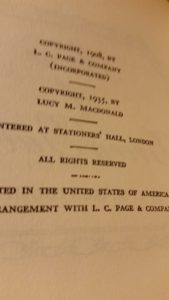 My edition dates back to 1935. I think it must have belonged to my Mom. I’ve been reading this book since I was nine or ten years old.
My edition dates back to 1935. I think it must have belonged to my Mom. I’ve been reading this book since I was nine or ten years old.One result of watching “Anne with an E:” it’s been far too long since I visited Avonlea and Green Gables. Time for another reread. I am sure I will forget about “Anne with an E” fairly quickly. After all, it wasn’t really about Anne Shirley anyway, just a loose interpretation of the original.
April 21, 2017
The morrim
I walked in Gordath Wood on Wednesday. Went right by the morrim and everything. Sometimes I’m taken by surprise by how much these Connecticut woods informed my first novel. It’s like visiting a movie set. Oh, there’s the ledge Lynn tumbles down. Oh, there’s the horse farm where the book begins. Oh, there’s the mysterious Balanced Rock in North Salem, NY, which plays an integral role in the novel.
Lynn peered into the woods, sharply uneasy. The
Be careful of the woods. You never know where you are going to end up.
broken boulders hulked under the trees, the sapling swaying in its stone prison, the vines fluttering. She heard whispers from the stone, voices just beyond the reach of her hearing. Just the wind, she told herself, looking harder and seeing nothing. The wind, or whatever it was, faded, like a conversation she was listening to on a distant radio. … It wasn’t the wind. She knew that. The whispering emanated from the split boulder, rising and falling, and she felt cold shivers spike along her spine at the sense of malice that tinged the distant words.
March 30, 2017
The Six Part III — Emma and Persuasion

“A heroine whom no-one but myself will much like” is Austen’s famous description of Emma Woodhouse. And yes, Emma is not very likeable. She is a self-important busybody who doesn’t even understand how badly she has ruined Harriet’s life. And that is the whole point of her involvement with poor Harriet. The girl is an illegitimate nobody of little value to Emma, so she feels she can do with her what she wants, under the guise of improving her life. And who doesn’t love the fact that Emma thinks she’s a whiz at matchmaking precisely because she introduced one couple to each other? One match! One match, Emma! That’s just beginner’s luck! Her smug self-importance knows no bounds.
Mr. Knightley does his best to open Emma’s eyes to the dangers of her scheming, and he gets really angry with her a number of times. Emma’s saving grace is that when she is called to account for her behavior, she does feel guilty. But Emma! Why does it take you so long to see that you are so mean to Miss Bates?
Like many Austen readers, Emma’s personality turned me off. But I’ve come to love the book, not just for the plot, but as always, for the wonderful background that Austen draws of the little village that is the setting for Emma’s antics. Also, how can you not love these lines, when her brother-in-law gives her instructions for taking care of her nephews:
“Well, Emma, I do not believe I have any thing more to say about the boys; but you have your sister’s letter, and every thing is down at full length there we may be sure. My charge would be much more concise than her’s, and probably not much in the same spirit; all that I have to recommend being comprised in, do not spoil them, and do not physic them.”
Yeah, basically he’s saying, your sister wrote down a whole long list of instructions about taking care of the boys. I’ve got two rules: Don’t spoil them, and don’t let your father give them medicine. For a woman who famously never married and never had children, Austen knew a whole hell of a lot about what whackjobs parents are. Just wait until we get to Persuasion.
And then there’s Mrs Elton. Oh, Mrs. Elton. She marries Mr. Elton, who Emma had designs on for Harriet, and immediately takes on the role of the leading member of society — not knowing that Emma already has that job. The two clash, and for all that Emma is so annoyingly obtuse, Mrs. Elton makes her look as if she’s the most introspective heroine this side of Sylvia Plath. (Sorry — too soon?) Anyway, Mrs. Elton, with her caro sposo, and her pastoral picnic in which she arrives on a picturesque donkey, and the ball at the community center (what? It’s totally a community center!), drives Emma nuts.
And then there’s the paragon of virtue, Jane Fairfax. I don’t get Jane, but we’re not supposed to get Jane. Jane is there to be the person Emma is supposed to aspire to be, and Emma is so incredibly jealous of Jane, and Jane has far more serious problems that she can’t do anything about, so she has no time to feel anything other than annoyed by Emma, as if Emma were a gnat. For one thing, she’s engaged to Frank Churchill.
With every Austen novel, there’s always one thing that I come up against as a headscratcher, and in this case it’s Frank and whatever Jane saw in him. Then again, Anne’s mother in Persuasion also fell for a stupid man, and Mr. Bennet is famously contemptuous of Mrs. Bennet, so bad marriages are a pretty common theme in Austen’s books. Maybe one of Austen’s goals was to warn her fellow women. No matter how pretty the boy is, make sure you respect him too.
So why is Emma Austen’s masterpiece? It is the most assured of all her novels. She doesn’t put a foot wrong at any moment. Everything works, from plot, to character, to setting, to dialog — she is at the top of her game. As I said, I love Persuasion the best of all Austen’s books, but Emma, man — Emma is amazing. If you haven’t read it in a while, or if you’ve only seen the adaptations with Gwyneth Paltrow or Romola Garai, you owe it to yourself to visit Highbury.
Oh: Not a romance. Yes, she finally marries Mr. Knightley, and Harriet marries her farmer, Mr. Martin, and the whole book revolves around Emma’s attempts at matchmaking, but this is so not a romance. In fact, this is like the anti-marriage plot, and I wouldn’t be surprised if Austen was doing that on purpose.
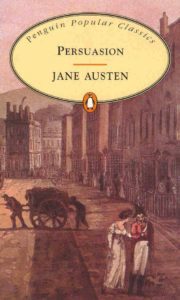 Persuasion
PersuasionOh, Persuasion. Best of all Austen novels. It’s unabashedly a romance, and a Romance, with its depiction of the wildness of nature (the seaside, where Louisa falls) and the melancholy of autumn echoing the melancholy of Anne Eliot. Although Persuasion ends up in Bath, its heart is in the countryside. Austen describes the natural world with a yearning that is missing from her other novels. I think it’s the most personal of her work.
In Persuasion, Austen illustrates family dynamics and human nature in scenes so modern as to be almost uncanny. Here are some examples:
Mary’s declaration was, “I hate sending the children to the Great House, though their grandmamma is always wanting to see them, for she humours and indulges them to such a degree, and gives them so much trash and sweet things, that they are sure to come back sick and cross for the rest of the day.” And Mrs. Musgrove took the first opportunity of being alone with Anne, to say, “Oh! Miss Anne, I cannot help wishing Mrs. Charles had a little of your method with those children. They are quite different creatures with you! But to be sure, in general they are so spoilt!”
The visitors took their leave; and Charles, having civilly seen them off, and then made a face at them, and abused them for coming, began with —
And this is straight out of an American high school:
“She is pretty, I think; Anne Elliot; very pretty when one comes to look at her. It is not the fashion to say so, but I confess I admire her more than her sister.”
“Oh! so do I.”
“And so do I. No comparison. “
I could quote from Persuasion for pages, but will restrain myself, except to mention The Letter. The letter is Captain Wentworth’s Grovel, in which he apologizes for being angry and insulted when Anne turned him down ten years before. Go read the book. When you get to The Letter, you’ll see what I mean.
The theme of influence and persuasion run through all of Austen’s books. In P&P, it’s Darcy’s influence over Bingley, for instance. In Persuasion, Lady Russell is guilty of convincing Anne of turning down Wentworth when they were young. She’s practically a mother to Anne, and she saw exactly what happened when her friend married a pretty face — she married Sir Walter Elliot. She wanted to spare Anne that fate. But Austen sticks to her guns. Persuasion never turns out in the best interests of the persuadee.
I’ll leave it to other readers to wonder if Austen’s continued return to the action of persuasion is a clue to her own happiness and unmarried state. I for one am glad that she never married, because if she had, I doubt she would have written her books. But she does redemption very well, and Persuasion is a ripe example of it. Anne and Wentworth get their second chance at love, and only the most curmedgeonly reader would have it otherwise.
Persuasion: Most definitely, gloriously, emphatically A Romance.
March 17, 2017
The Six Part II — Sense & Sensibility and Northanger Abbey
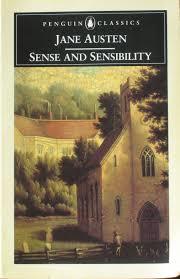
For a lot of readers, Sense & Sensibility pales by comparison to Pride & Prejudice. Its structure is so similar to the more famous work — two sisters, straitened circumstances, witty dialog, and finally, married happiness and financial comfort — that the public can be forgiven for considering it Pride & Prejudice Lite.
But as with anything by Austen, S&S has unexpected depths and sparkling characterization, as well as a keen understanding of human nature, and how the deck is stacked against women in how their fate is determined.
At this stage in my re-reading of Austen’s body of work, I focus less on the romance and more on her descriptions of family, character, society — all the background stuff. Austen’s characters in Sense & Sensibility leap off the page (with the exception of Edward Ferrars. He’s very dull, but he entirely suits Eleanor, so they are a great match). Marianne is such a goof. Their little sister Margaret acts exactly the way a twelve-year-old should. Colonel Brandon, Lucy Steele, John Dashwood, who lets his wife talk him down from bestowing a comfortable living on his step-mother and sisters to an occasional gift of a few pounds here and there — we know these people, because human nature does not change.
And with all of Austen’s keen insight into society and people, she also wrote a mighty fine romance. Yes — S&S is a romance. You have two people crossed in love, there’s sex although it happens offstage, there’re any number of romantic heroes and foils (Brandon and Willoughby, and dull Edward Ferrars), there’s bad behavior (Willoughby and Ferrars), and a romantic sensibility permeates the book.
There’s even a Final Obstacle (Marianne confronting Willoughby at the ball) and a Big Fat Misunderstanding (When Eleanor thinks that Edward has married and it turns out nope, he has not.) Now, as modern readers we are primed to see the loss of Willoughby as a bad thing, but it’s really a bait and switch. Colonel Brandon is perfect for Marianne, and we all know it. Jane Austen is really working the marriage plot, and honestly, this feels like the book that invented it.
Emma Thompson’s screenplay does such great justice to Sense & Sensibility. It’s a lovely movie that matches a lovely book. It’s not my favorite Austen, but it’s the favorite of many fans for all the reasons that people love a fabulous story. Now I have the urge to re-read it.
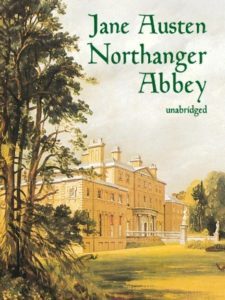 Northanger Abbey
Northanger AbbeyNorthanger Abbey is a record-setting book. It might be the earliest mention of baseball in literature, and it may also be the first example of fanfic. Yes. Northanger Abbey is an affectionate homage to gothic novels.
This book is just fun. Catherine Morland is a YA heroine who is emphatically not a Gothic romance lead. She’s normal, not too pretty, has just gotten out of her gangly tomboy stage, and her parents say things about her like, “Catherine looked almost pretty today.” She’s a dreamer and a reader too. She’s kind, innocent but also practical, and you would definitely want her to babysit your twins, if she somehow got transported to the Babysitter Club books, or Sweet Valley High.
I love Catherine Morland.
So what happens is, this ordinary girl is transported into a Gothic novel in the most prosaic way, thinks she is in a murder mystery, insults the young man she has a crush on, they make up, and then, because the boy’s father is a control freak alpha male, gets sent home by herself, and has to borrow money from her dear friend, her crush’s sister, to pay the stagecoach fare.
Imagine having to travel several hundred miles by yourself on a Greyhound when you’re a protected teenager, and there are no cellphones, and your parents aren’t expecting you and don’t know what happened to you. Catherine manages the Regency equivalent, and it’s a bit scary, but she’s fine. And that’s her adventure! That’s her Gothic mishap! She has to get on a stagecoach and come home to her entirely normal family. This is like a 1960s teen novel. Catherine Morland and Beezus would be best friends. I know it.
The visit to Northanger Abbey stands in stark contrast to Catherine’s stay in Bath. I’m pretty sure that Austen hated the place, and she calls out the Pump Room for what it is — overcrowded, uncomfortable, and a meat market. We have this image of the Regency era being oh so pretty and lovely, but we don’t have to read far between the lines to get at the realistic parts. And as always, Austen shines when she’s writing her villains. The manipulative brother and sister pair, John and Isabella Thorpe, are soooooo nasty. They know exactly how to maneuver Catherine, and they flat out lie to her when they trick her into standing up her real friends. They are absolute jerks. Isabella gets her comeuppance. John is a self-involved fratboy type, and there again, some character types never change. Oh and by the way, bad driving is bad driving, whether it’s a car or a carriage. John Thorpe is a bad driver who thinks he’s a good one, and it’s pretty harrowing.
Anyway, what with one thing or another, Catherine ends up marrying Henry Tilney, and again, her mother has the best line.
“I give it six months. Four, if she cooks for him.”
No! Wait! That’s from Parenthood. What Mrs. Morland says is, “Catherine would make a sad, heedless, young housekeeper to be sure.” But it’s the exact same idea and it’s delivered with the exact same sense of parental resignation. This is why people who think of Jane Austen as old-fashioned have no freaking idea.
Of all Jane Austen’s leading men, Henry Tilney is the one to whom I give the most side-eye. I don’t like him. He thinks he’s very clever, and I think he likes the idea of having a guiless young wife. He better be good to Catherine, or I might have to have strong words for him.
Yes, have I mentioned how much I love Catherine Morland?
Anyway, for those keeping score. Northanger Abbey: Not A Romance.
Next up: Emma and Persuasion, or, Austen’s masterpiece and my favorite of hers, respectively.
March 12, 2017
The Six — an analysis of Jane Austen’s novels
The six are the Jane Austen canon — Pride & Prejudice, Sense & Sensibility, Persuasion, Northanger Abbey, Mansfield Park, and Emma. The following is my analysis of the six, in no particular order.
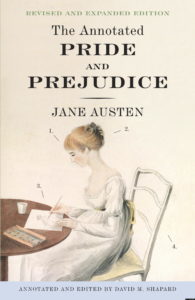 Pride & Prejudice
Pride & PrejudiceI first read Pride & Prejudice in high school and didn’t like it. I picked it up again when I was 25, at loose ends with my life, and a few months away from drawing stakes and moving from Connecticut where I grew up, to Austin, Texas, a monumental move that changed the trajectory of my life.
I’ve re-read it dozens of times since, especially my several close reads prior to writing The Unexpected Miss Bennet. And I’ve grown to both like it less and appreciate it more. For one thing, over-familiarity can render even the best-loved novel a bit tattered and faded. What was once the brightly colored experience of a beloved re-read suffers from a closer examination that reveals the age marks and the water spots.
But damn, it is probably one of the most perfect novels ever written. It has just enough imperfections to make the good stuff stand out, and to keep English doctoral students in business studying what Austen actually meant when she wrote that. For instance — Lizzy’s very odd conversation with Wickham at the end. Or whether Lizzy fell in love with Darcy before or after she saw his house. Or who is the worse parent — Mr. Bennet or Mrs. Bennet?
Adaptations of Pride & Prejudice emphasize the romance, but the novel itself is not a romance, even if it makes use of a modern romance trope — The Grovel. Darcy has done a pretty unthinkable thing, by influencing Bingley to dump Jane Bennet. He redeems himself by finding Lydia, making Wickham marry her by providing the bulk of the payout, and even takes responsibility for Wickham seducing Lydia in the first place. And he does it all without expecting anything of Lizzy. When he changes Bingley’s mind again (we’ll see this crop up again in Persuasion and Emma), that’s for Lizzy, because it removes the Final Obstacle, which is another modern romance tactic. And it works, of course.
Austen wasn’t writing romance. She was writing commentary on middle class society. She’s more Anne Tyler than Nora Roberts. P&P does follow the marriage plot, but I still see it less of romance and more of a contemporary novel of manners and morals and society.
Mansfield Park
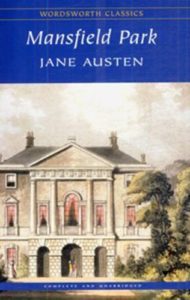
From Austen’s best-loved novel to her most misunderstood, you won’t find two novels more different from one another. I think that even Jane Austen’s contemporary readers found Mansfield Park puzzling and unlikeable. It’s a barbed commentary on smug, pompous, foolish middle-class society, whose money comes from trade. Austen isn’t just looking down on the merchant class. If current scholarship is correct, she is making a direct statement about people whose fortune came from slave labor. She is also taking on meanness, hypocrisy, and self-deceit. Nobody is likeable, even Fanny. In fact, Fanny is such a pain in the ass. She’s timid, mealy-mouthed, a milksop, no fun to be around, a killjoy, and everybody’s favorite whipping post.
And that girl stands firm. Every one of her Christian beliefs is tested and she never gives an inch. Of course nobody likes her! She lives according to her principles! She’s very un-modern, which is why modern readers don’t like her, and she is a direct rebuke to her contemporaries, who probably disliked her for the same reason.
Despite all that (“other than that, Mrs. Lincoln…”) Mansfield Park is an engaging read. It’s not an easy book but it is amazing at how modern the language is. Austen is an opaque writer, and Mansfield Park is a thick book, but some things jump out. At one point, Maria asks her aunt, Mrs. Norris, if she’s been sponging again, meaning exactly what we mean when we say someone is sponging off someone.
Mansfield Park is almost Dickensian. My favorite part of the novel comes near the end, when Fanny goes home to visit her family. They are very poor, and they live in squalor and discontent, and there is something so marvelous about that description because it is so different from P&P, and even different from Sense & Sensibility, and the Dashwoods are very poor. But this is different, and we see it. The Price family is rowdy and quarrelsome, and they don’t have even a bit of gentility, and Fanny is ashamed of them, and ashamed of being ashamed.
We have this image of Jane Austen being drawing room nice — sprigged muslin and china cups and dances at the Pump Room, and all of that. The Price family gives a lie to all that. Those people are real, and the only way to write a family like that is to know it.
One other thing that becomes very clear is that Austen loves her some sailors. This comes across in Persuasion as well. Mansfield Park comes alive with Fanny’s love for her brother, who has gone to sea, and the description of Portsmouth and the docks.
Mansfield Park is decidedly not a romance, even if it ends with Fanny and Edmund together. I think that’s why film adaptations have failed. The movie didn’t quite get at the point of the novel, and the miniseries was just plain lousy.
Next installment: Sense & Sensibility and Northanger Abbey.
January 26, 2017
Woke up in Mordor
I went to bed in the Shire, woke up in Mordor,
Exchanged comfort for horror
And complacency for fear.
But the world that I woke in
Is the same some folks walk in,
And it’s not their fault
This map isn’t mine.
I’ve just been lucky,
Protected by borders,
And locks on the doors.
Didn’t know that orcs had their orders,
Didn’t know the choice wasn’t mine.
Went to bed in the Shire, woke up in Mordor,
Not sure how I got here,
It’s kind of familiar, kind of a nightmare.
Don’t climb the towers
Keep low to the shadows
Don’t raise your head up
Watch out for spiders.
Maybe the Shire was always in Mordor,
Maybe Mordor was always in us.
Hold up the palantir and look at your peril,
Don’t look away til you’ve seen what you must.
Went to bed in the Shire, woke up in Mordor,
Exchanged comfort for horror
And complacency for fear.
Not sure what I’ve got here, neighbors or strangers,
Not sure of the danger, not sure of the fear.
Always thought orcs deserved what they got there,
Beginning to wonder if that’s out of order.
Don’t climb the towers
Keep low to the shadows
Don’t raise your head up
Watch out for spiders.
Fell asleep in the Shire, woke up in Mordor,
Maybe the Shire was always in Mordor,
Maybe Mordor was always in us.
December 31, 2016
Writing Goals 2017
My 2017 Writing Goals (and maybe they can help you too):
Write even when– no, especially when– I’m tired or not feeling it, or think don’t have time.
Commit to the story. I have too many novels and stories that have languished. The worst story ever completed is a thousand times better than the best fragment or chapter.
Commit to the language. I used to say good writing should disappear in service to the story, but I’ve softened on this; good writing is a joy that serves the story, knows when to call attention to itself, and when to let the plot take center stage. Talented and accomplished author Jessica Reisman and I have argued on this in the past, and she will be happy to know that I’ve come round toward her point of view.
Take joy in writing but also remember that writing can be a hard slog. Remember, writing is easy for everyone except writers. Since it’s so hard, might as well do it right.
November 26, 2016
Bugs Bunny and the Election of Donald Trump
 What’s up, Doc? The carrot-smacking, trouble-making, cross-dressing, opera-loving rabbit, the bane of Elmer Fudd’s existence, encapsulates the American psyche. He’s a trickster, a rogue, a mischief-maker — in an earlier incarnation he was Brer Rabbit, and in still earlier forms he was another species entirely — Anansi the spider or Coyote, or any of the many animal avatars of the trickster god.
What’s up, Doc? The carrot-smacking, trouble-making, cross-dressing, opera-loving rabbit, the bane of Elmer Fudd’s existence, encapsulates the American psyche. He’s a trickster, a rogue, a mischief-maker — in an earlier incarnation he was Brer Rabbit, and in still earlier forms he was another species entirely — Anansi the spider or Coyote, or any of the many animal avatars of the trickster god.
It was the spirit of Bugs Bunny that had a lot to do with the election of Donald Trump.
Somewhere along the way, we infantilized the stories of the Trickster God, smoothing out all the evil and nastiness and turning them into stories for children. All those stories of Coyote’s adventures where he gets his comeuppance gloss over the parts where Coyote is truly a harmful entity — chaotic neutral at best or chaotic evil. There are plenty of Native American stories about Coyote that are warnings about him, but all everyone remembers are the funny stories.
 Same thing happened to Loki. In Norse mythology he causes trouble just for the sake of it, and causes Baldur’s death. But now he’s played by Tom Hiddleston, and he’s gone from chaotic evil to chaotic rowrr! And no, I didn’t bring this up just so I could find a picture of Tom Hiddleston as Loki. Okay. Maybe a little.
Same thing happened to Loki. In Norse mythology he causes trouble just for the sake of it, and causes Baldur’s death. But now he’s played by Tom Hiddleston, and he’s gone from chaotic evil to chaotic rowrr! And no, I didn’t bring this up just so I could find a picture of Tom Hiddleston as Loki. Okay. Maybe a little.
I think everyone feels like they have a little bit of Bugs Bunny in them. That’s why the impulse to overturn the applecart was strong enough in overwhelming numbers of people. The same spirit that animated a great many Bernie Sanders supporters could be found in their political opposites, Trump supporters. And everyone thinks the Trickster spirit is mischievous and roguish. You know, Han Solo. (Totally shallow, I admit it straight up.)
Because we equate the Trickster with Bugs Bunny or Coyote with a bandanna, or Tom Hiddleston, we forget the actual, real, true power of shaking things up just for the sake of shaking things up. We think it’s not going to be that bad. We just want to shake the gameboard a bit. And because we’ve stopped telling the real, true dangerous myths about Coyote, we didn’t know what we just wrought.
An entire country turned Trickster on itself.
Now, the destructive spirit is a necessary spirit. The rule of law without the trickster is authoritarianism, fascism. But the rule of the trickster without law is anarchy. With the incoming leadership, we get the worst of both worlds — the authoritarianism we’ve just seen, with the images of racist white nationalists saluting Donald Trump with a Nazi salute, combined with the expedient nature of Trump’s platform. The people in power are a brutal combination of authoritarianism and anarchy — they stand for nothing except their own profit, so everything is fair game. Come January 21, we will actually have a power vacuum.
Don’t take the trickster for granted. The trickster god isn’t Bugs. He’s not adorable Coyote, making mischief and getting his comeuppance. The US played with dangerous forces in this last election. Mythology is not to be taken lightly. Even if we don’t know the true stories, we’re still at their mercy. When the gods come out to play, mortals are the ones who get hurt.
*All images copyright their respective creators.



